
WASHINGTON — Over the past few years, some Democrats — including the Clintons — have offered a new explanation for why they supported the Defense of Marriage Act in 1996.
The threat of a federal constitutional amendment, these Democrats have argued, motivated them to support DOMA — a law that defined marriage for federal government purposes as between one man and one woman and said states could refuse to recognize same-sex couples’ marriages from others states.
“We were attempting at the time, in a very reactionary Congress,” Bill Clinton told an audience in 2009, “to head off an attempt to send a constitutional amendment banning gay marriage to the states.” Four former senators — including Tom Daschle, who made the claim in 2011 — raised the idea in a Supreme Court brief in 2013. Clinton later cited that brief when, in a Washington Post op-ed, he called for the law he signed to be struck down by the court. Hillary Clinton just last week called her husband’s decision to sign DOMA “a defensive action.”
There is no contemporaneous evidence, however, to support the claim that the Clinton White House considered a possible federal constitutional amendment to be a concern, based on a BuzzFeed News review of the thousands of documents released earlier this year by the Clinton Presidential Library about same-sex couples' marriage rights and the Defense of Marriage Act. In the documents, which include correspondence from a wide array of White House and Justice Department officials, no one even hints that Bill Clinton’s thinking or actions regarding DOMA were animated by the threat of a federal constitutional amendment.
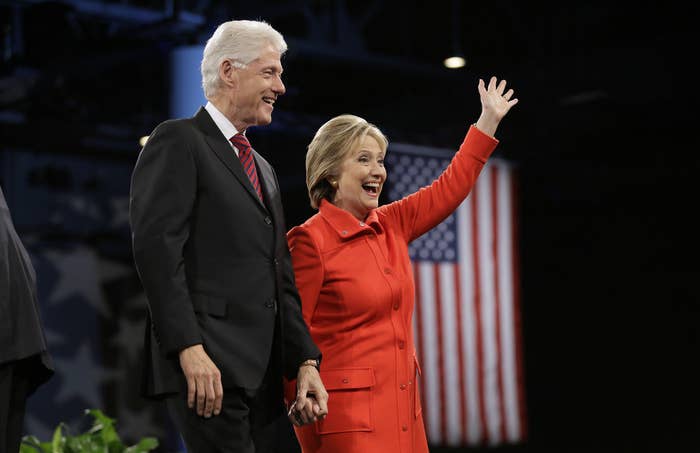
The claim has faced renewed scrutiny in recent days after Hillary Clinton made an extended argument in an interview with MSNBC’s Rachel Maddow that DOMA was a “line to be drawn” to prevent further action.
“I think what my husband believed — and there was certainly evidence to support it — is that there was enough political momentum to amend the Constitution of the United States of America, and that there had to be some way to stop that,” she told Maddow.
“I was in on some of those discussions, on both ‘don’t ask, don’t tell’ and on DOMA, where both the president, his advisers, and occasionally I would chime in and talk about, ‘You can’t be serious, you can’t be serious.’ But they were,” Hillary Clinton said. “And so, in a lot of ways, DOMA was a line that was drawn, that was to prevent going further.”
Maddow pressed here, asking, “It was a defensive action?”
“It was a defensive action,” she replied.
In the days since, many longtime LGBT advocates have called the comments inaccurate — and her leading opponent for the Democratic nomination, Bernie Sanders, who voted against the legislation as a congressman, criticized her implicitly but sharply, onstage at the Jefferson-Jackson Dinner in Iowa.
By Monday afternoon, Hillary Clinton spokesperson Brian Fallon had pulled back a bit, telling the Huffington Post, “Whatever the context that led to the passage of DOMA nearly two decades ago, Hillary Clinton believes the law was discriminatory and both she and president Clinton urged that it be overturned.”
He did not, however, say whether Clinton stood by her comments — and her version of history.
At her husband’s presidential library in Little Rock, Arkansas, however, the history is clear. There was no documented discussion in 1996 within the White House or Justice Department about any momentum for a federal constitutional amendment that DOMA was intended to prevent.
For the most part, White House staffers assumed Clinton would eventually support DOMA once the bill’s introduction was certain. Bill Clinton had already stated his opposition to same-sex couples’ marriage rights. In 1996, Clinton repeatedly marked his approval of talking points on same-sex marriage, as it is referred to in the documents and will be referred to throughout this report, and DOMA; the talking points included his opposition to same-sex marriage and opposition to providing federal benefits to same-sex couples.
While some of the few out gay employees and their strongest straight allies worked in the spring of the year to find a way to keep Clinton from supporting DOMA, the internal conversation surrounding the bill mostly concerned when Clinton would announce his support.
And Clinton ended up announcing his support sooner rather than later. On May 23, 1996 — less than three weeks after the bill was introduced in Congress — Clinton announced that he would sign the bill if it came to him as he understood it.
Through it all, though, no one discussing the bill in the Clinton administration — from the White House senior staff to gay staffers and their strongest allies to the press office to Justice Department lawyers — ever mentioned any concern about a federal constitutional amendment.

During his 1992 presidential campaign, Bill Clinton had said he opposed same-sex marriage. Still, by the beginning of 1996, there was optimism inside the White House about how Clinton would treat same-sex couples during his re-election bid.
On Feb. 1, 1996, a law clerk in the White House Counsel’s Office wrote a memo about the same-sex marriage question, at the request of her superior.
Although no state would legalize marriage equality until 2004, the treatment of same-sex couples — and in particular the landmark marriage case in Hawaii — had begun to force consideration of the issue. So in the winter of 1996, associate counsel Marvin Krislov asked the law clerk, Chrysanthe Gussis, to do some research and draft a tentative statement on the issue.
“The administration believes that the legal status of same-sex unions, and the accompanying rights and benefits, should continue to be determined on the state and local level,” Gussis wrote in the draft statement.
In an “optional” section, she added: “The lack of legally recognized alternatives to marriage and the exclusion of gay and lesbian relationships from marriage have left many couples unable to define their relationships as they choose, and often has led to disparate and unfair treatment of similarly situated couples.”
In other words, in January 1996, a law clerk in the White House Counsel’s Office strongly implied that differing treatment of same-sex couples likely violated the Constitution’s guarantee of equal protection of the laws. And, perhaps, as Gussis put it, “states should give serious consideration” to same-sex unions.
By late March, however, the internal discussion had become more defensive. Marsha Scott, a straight woman who Clinton had named as his first gay and lesbian liaison, convened a meeting of gay and gay-supportive Clinton administration officials and Capitol Hill staffers.
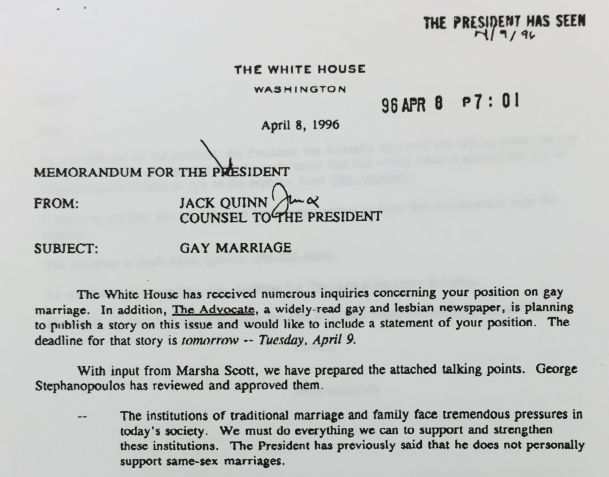
In the two weeks that followed, the group and others debated how the president should express his 1996 position on marriage. White House senior staff eventually settled on three bullet points, and Jack Quinn, the president’s counsel, provided them to Clinton on April 8 — noting that Scott gave input and that George Stephanopoulos had approved them.
“The institutions of traditional marriage and family face tremendous pressures in today’s society. We must do everything we can to support and strengthen these institutions. The president has previously said that he does not personally support same-sex marriages,” the first bullet point read.
The second noted that “many communities and institutions” were considering whether to offer “certain basic benefits … outside the context of traditional marriage.” Even those protections, however, face the “challenge” of “remain[ing] sensitive to the traditional values” of communities while “preserving the fundamental right to live free from unjustified discrimination.”
The final talking point noted that the country has “looked first to state and local governments, as well as the private sector, to consider issues like these.” It concluded, “The president believes that these issues continue to be best resolved at this level of civil discourse.”
A stamp confirms Clinton saw the “GAY MARRIAGE” talking points document — and the reverse checkmark that staffers say he used confirms his agreement with the three points.

Over the course of the next month, the hypothetical language in the talking points was put to the test as Rep. Bob Barr introduced the Defense of Marriage Act on May, 7, 1996.
Even then, though, nothing in the voluminous communications among members of the White House staff or between the Justice Department and White House mention any concerns about or even consideration of the possibility of a federal constitutional amendment that might explain support for DOMA.
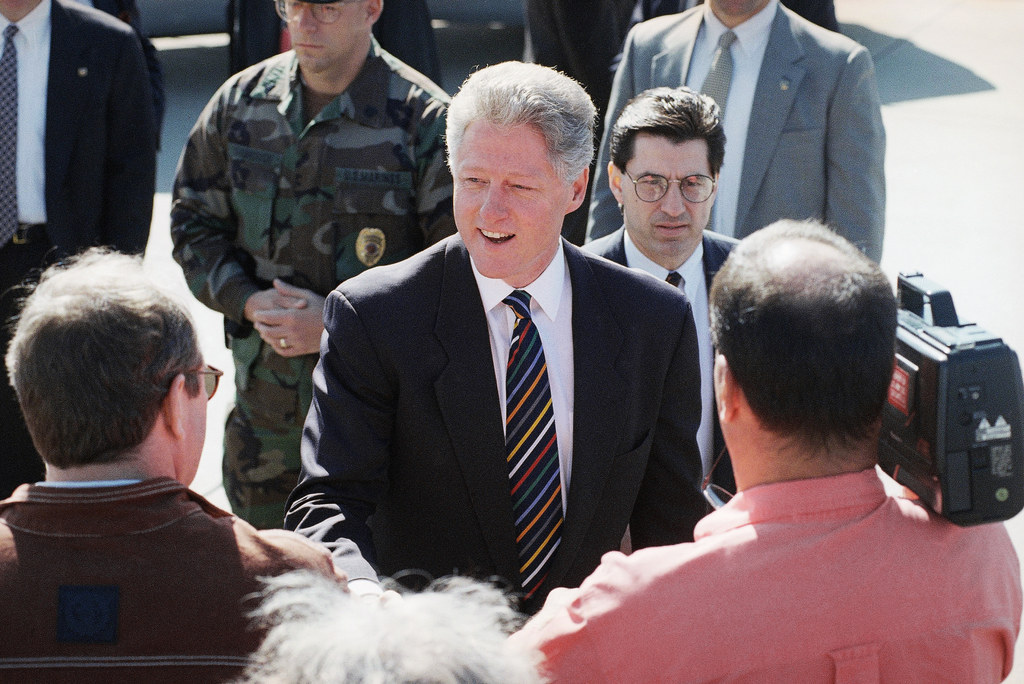
The story detailed in the discussions is simpler: Clinton opposed same-sex marriage and opposed federal recognition of same-sex couples’ marriages. Ultimately, then, he supported the substance of the bill — and efforts to get him to oppose the bill on federalism grounds or due to constitutional concerns were shut down within a week of the bill’s introduction.
DOMA had two substantive parts after its title section. Section 2 purported to give states the right to refuse to recognize same-sex marriages authorized by other states or jurisdictions, and Section 3 defined marriage for all federal government purposes as only being between one man and one woman.
The White House, which had already been deciding how to handle the same-sex marriage question from a legal and messaging perspective, now also began preparing for DOMA.
Harold Ickes, Clinton’s deputy chief of staff, and Stephanopoulos had previously asked the Justice Department whether the Constitution would require states to recognize same-sex couples’ marriages if Hawaii ended up allowing such marriages. On May 1, Quinn reported back that the Justice Department had concluded that states would not need to recognize such marriages.
On May 9, Quinn alerted Leon Panetta, Clinton’s chief of staff; Stephanopoulos; and Mike McCurry, the president’s press secretary, that DOMA had been introduced in the House. They advised that, if asked about the bill, Clinton should say that he had not yet had an opportunity to review the legislation.
Meanwhile, Scott and Richard Socarides, who was in the process of taking over from Scott as gay and lesbian liaison, were trying to come up with ways for Clinton to take a position against the bill. In May 9 memos, Scott sent Stephanopoulos and others language provided by Socarides as a potential administration position on the bill.
Arguing that “Congress has more important things to do,” Socarides suggested the White House should express concern about “legislat[ing] in quintessential state issues” and that its position should be: “The institutions of traditional marriage and family face tremendous pressures in today’s society. The president believes that we must do everything we can to support these institutions, but this particular legislation does not seem to advance that goal.” She also followed up with additional thoughts of her own.
The next day, Scott and Socarides sent a two-page memo to Ickes, arguing forcefully that Clinton should not back the bill because it would cause a serious rift with, as they put it, “our friends in the gay community.”
“[O]ur support of this bill would be taken by many in the gay communities as an expression by the president of deep ceded [sic] bias against gay people,” they wrote, urging Clinton to oppose the bill as an “unwarranted intrusion” on states’ role in defining marriage or, if not that, at least say that he is withholding judgment while “the Justice Department is studying the serious constitutional issues raised by the legislation.”
At the same time, however, the Justice Department recommended that Clinton back the bill.
“Given the president’s opposition to same sex marriage, it would seem to me to make sense to make clear as quickly as possible that, in light of that opposition, he supports enactment of the proposed statute.”
In a two-page memo, Associate Attorney General John Schmidt wrote that it would be difficult to explain how opposition to DOMA was compatible with opposition to same-sex marriage. “Given the president’s opposition to same sex marriage,” Schmidt wrote, “it would seem to me to make sense to make clear as quickly as possible that, in light of that opposition, he supports enactment of the proposed statute.”
The senior staff took Schmidt’s advice. In a memo dated May 10, Quinn, Stephanopoulos, and Scott wrote to Clinton that “there would not be a substantive basis” for him to oppose DOMA and recommended that he “sign this legislation if it is enacted.”
They also, however, wrote that the the White House could reiterate Clinton’s stated opposition to same-sex marriage but add “that there has not yet been an opportunity to review this legislation” — a nod toward Scott and Socarides’s last-ditch recommendation. Only “[i]f and when this approach is no longer viable,” they recommended, should the White House state that Clinton would sign the bill.
The document — bearing the reverse checkmark — is noted as not having been seen by Clinton until May 14. As with the prior talking points memo reviewed by the president, the memo contained no mention of any concern about a federal constitutional amendment as a reason to support the legislation.
While that memo was sitting on Clinton’s desk, McCurry, the press secretary, struck the first blow to the viability of the “wait-and-see” approach. At the press briefing on May 13, McCurry responded to a question by saying that Clinton opposed same-sex marriage. Asked why, McCurry said, “He believes this is a time when we need to do things to strengthen the American family.”
The comment caused a stir, outside and inside the White House. In later communications, staffers argued that McCurry went beyond the April talking points in his comment by directly connecting Clinton’s opposition to same-sex marriage to his desire to strengthen the traditional family. In the talking points, the sentiments were in separate sentences in the same bullet point. McCurry, however, walked the comments back the next day, saying that Clinton opposed same-sex marriage but that McCurry had not “gone deeper into the moral philosophy behind it” with Clinton.
Over the next few days, a second event made the “wait-and-see” approach exceptionally difficult to maintain. In a letter from the Justice Department, Assistant Attorney General Andrew Fois informed Rep. Henry Hyde, the chair of the House Judiciary Committee, “The Department of Justice believes that [DOMA] would be sustained as constitutional, and that there are no legal issues raised by [DOMA] that necessitate an appearance by a representative of the Department.”
Although the letter was dated May 13, it was not made public until the morning of the first House hearing on DOMA two days later — to the disappointment and consternation of Democratic opponents of DOMA on the Hill and LGBT advocates fighting the bill.
White House officials have previously maintained that the White House was caught off guard by the letter. But one document found in the Clinton library files proves that, at the least, the White House Counsel’s Office was kept informed about drafting of the letter. Walter Dellinger — a senior lawyer in the Justice Department who had previously worked in the Counsel’s Office — sent a memo to Quinn on May 14, noting that the Justice Department had prepared “a new version of the Defense of Marriage letter,” taking out reference, Dellinger wrote, to Clinton’s opposition to same-sex marriage.
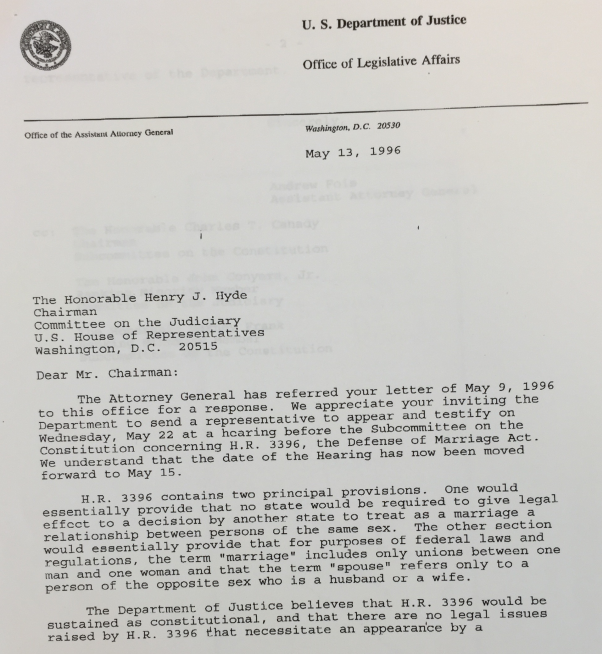
As the Justice Department letter was being finalized and sent to the Hill, a new set of White House talking points emerged after some internal debate — and after approval by Clinton. The talking points, while not declaring outright support for DOMA, left little question about where the president stood. They were faxed from Stephanopoulos to Scott and White House legislative affairs staffer Peter Jacoby on May 14 — the day before the congressional hearing. As with the prior two documents reviewed by Clinton, there was no reference to any concern about a federal constitutional amendment.
“The president has long opposed gay marriage,” the first bullet point noted. The second stated that Clinton “strongly believes that gay and lesbian individuals should not be subject to unfair discrimination,” but added that “he does not believe that the federal government should promote gay marriages.”
In case those two points left any doubt, a third point was added for if someone was asked about “domestic partnerships or providing federal benefits.”
Starting out by repeating prior statements about the decisions being “best left to state and local governments and private institutions,” the May 14 talking points added a comment that appears to be nothing less than unambiguous support for Section 3 of DOMA: “[S]ince the president does not believe that the federal government should recognize gay marriage, he does not believe it is appropriate for federal resources to be devoted to providing spousal benefits to partners in gay and lesbian relationships.”
The Justice Department letter was made public on May 15 — the first step toward the administration’s endorsement of DOMA — and staffers were going around with new talking points that effectively endorsed both provisions of the bill.
Nonetheless, Scott and Socarides attempted to downplay the meaning of the Justice Department’s letter, urging that, if asked, McCurry should say, “This was a routine letter sent in response to a routine request for testimony. You should check with the Justice Department for further information on this decision.”
The claim was a bit disingenuous, given the new talking points — and the fact that Scott had sent the memo to Clinton the previous week recommending that Clinton sign the legislation if passed by Congress.
As Socarides and Scott were trying to control the public fallout from the Justice Department letter, however, Scott was preparing a path to break the news to Clinton’s gay and lesbian appointees that he would be supporting the legislation if passed.
In a memo to Vice President Gore, who was due to host a historic gathering of out gay and lesbian appointees in the administration, Scott laid out the DOMA situation — including McCurry’s comments and Fois’s letter and the senior staff recommendation that Clinton sign DOMA if passed. She then gave him his task. “You must address this issue with the appointees,” Scott wrote, noting, “You have great respect within the gay and lesbian communities. … The president is being identified with the problem. You are not.”
It would be another week before President Clinton addressed the bill publicly, but the outcome was set — and there had been no mention, by anyone discussing the matter with the White House staff working on the bill, of concern that, without DOMA, there was momentum for a federal constitutional amendment.

The only question left was how long it would be before the White House, or Clinton himself, announced that he would sign the bill.
It turned out, not long at all.
On May 20, Scott was still optimistic, writing to Janice Enright, the special assistant to Ickes, that Ickes “promised” to put together a meeting “to discuss the next step on this same-sex marriage issue.” Noting that Gore had a trip to New York City in the coming days and Clinton had a bill-signing — of the Ryan White CARE Act Amendments of 1996 — later that day, Scott wrote, “Someone will ask. Everybody better be ready.”
“Someone will ask. Everybody better be ready.”
The day after the bill-signing, Jeffrey Levi, the deputy director of the Office of National AIDS Policy, sent around talking points about DOMA and same-sex marriage that Scott reviewed — talking points “NOT cleared by Harold Ickes” but that Eric Fanning, then a staffer in Ickes’s office, said reflected “everything they have been saying.” Among the points was one that “[t]he president has not taken a formal position on the legislation now pending in Congress — and he is unlikely to do so unless and until it comes to his desk.”
Less than 24 hours later, though, that talking point met its end.
McCurry told reporters that Clinton would sign DOMA if passed in its current form.
The next day Clinton said so himself, although he caused additional problems for the White House by inaccurately describing the bill at a news conference in Milwaukee.
“[A]s I understand it, the only legal effect of the bill is to make it clear that states can deny recognition of gay marriages that occurred in other states. And if that’s all it does, then I will sign it,” Clinton said — ignoring Section 3 of DOMA in his comments and going on to talk about how he opposed discrimination. “Name me another president who has been so pilloried for standing up for the fact that we shouldn’t discriminate against any group of Americans, including gay Americans, who are willing to work hard, pay their taxes, obey the law, and be good citizens.”
Clinton made no comments about being concerned about momentum for a federal constitutional amendment barring same-sex couples from marrying, instead saying, “[T]his has always been my position on gay marriage It was my position in ’92. I told everybody who asked me about it, straight or gay, what my position was. I can’t change my position on that; I have no intention of it.”
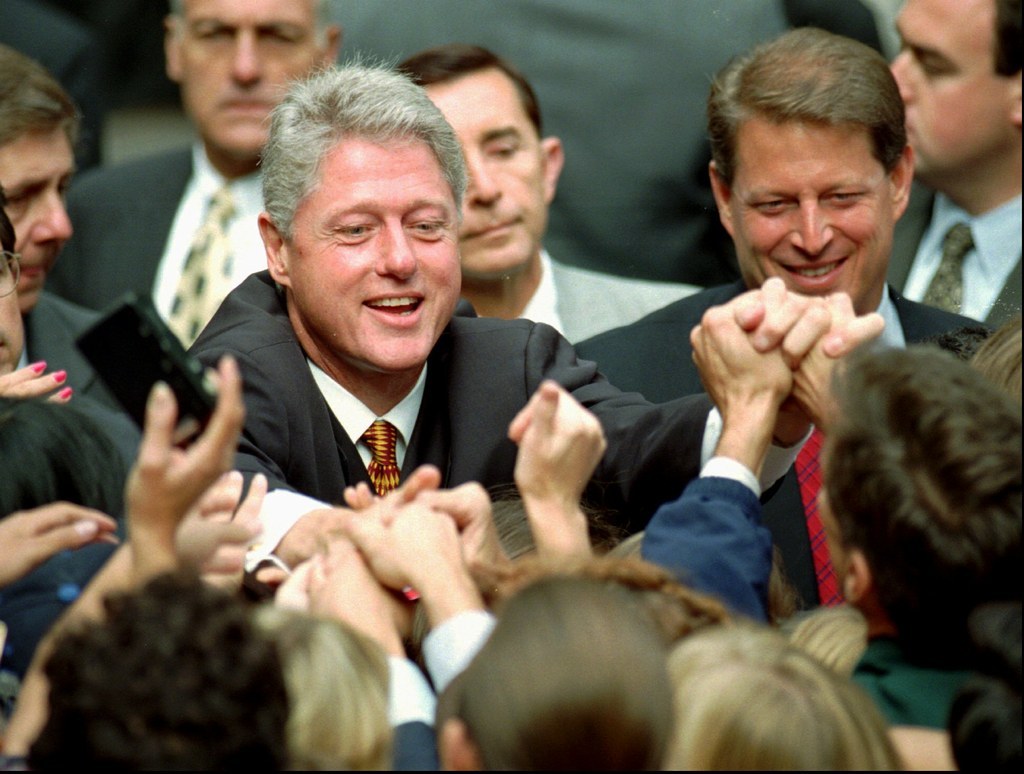
Gore, for his part, was more circumspect in comments made the same day. While saying that he, like Clinton, believed marriage is the union between a man and a woman, a White House staffer, Patricia Lewis, detailed, “He was asked whether the legislation in Congress was needed and he said some think yes, some think not, but that the president had indicated he would sign it.”
Over the course of the days that followed the president’s announcement, Scott was dealing with fallout.
“This is being seen as a clear and calculated signal from the White House that we are abandoning the gay and lesbian constituencies,” she wrote to Fanning, noting that Stephanopoulos was “publicly uninvited” from a Human Rights Campaign dinner in San Francisco and that donors in New York “are saying they will not work on the New York fundraiser.”
None of Scott’s comments to Fanning — even in this low moment for Clinton’s strongest advocates on gay issues — suggest that the administration should consider explaining Clinton’s support for the bill as being justified as a measure to stop something worse: a federal constitutional amendment.
The next week, Scott was continuing to deal with fallout, noting in an email to Enright that some of the most prominent donors and establishment advocates of the day within the gay community — Jeff Soref, Jim Hormel, Sky Johnson, Keith Boykin, Elizabeth Birch, Hilary Rosen, and Dr. Scott Hitt — had requested a meeting with Clinton.
“These are our friends,” Scott wrote. “They want to help but need our help to do so.”
The group meeting did not happen, one of the potential attendees told BuzzFeed News this week.

The White House formally issued its “Statement of Administration Policy” regarding DOMA on July 11, detailing in advance of the House of Representatives vote on the bill that, although Clinton “strongly opposes discrimination against any group of Americans, including gay and lesbian individuals,” he nonetheless “has long opposed same sex marriage.”
It concluded: “Therefore, if H.R. 3396 were presented to the president as ordered reported from the House Judiciary Committee, the president would sign the legislation.”
The next day, the House passed DOMA on a 342–65 vote.
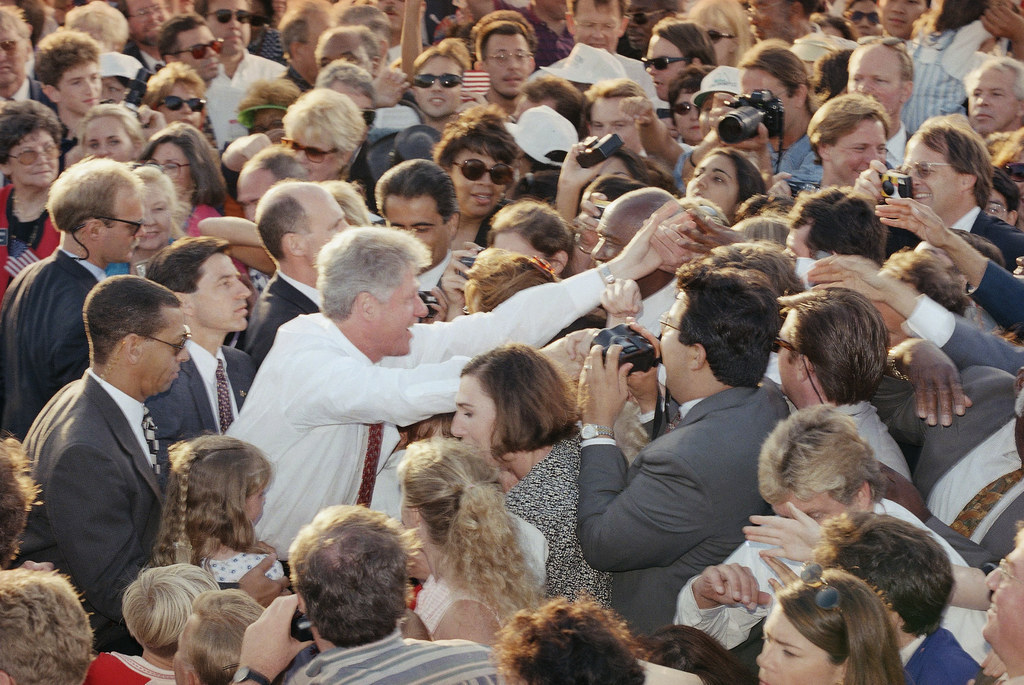
Further White House discussions, including a memo from Socarides to Clinton the next week, focused on how to move beyond DOMA and, as Socarides put it, “We may then talk about your accomplishments — from appointments to your endorsement of the Employment Non-Discrimination Act to the removal of barriers in the granting of security clearances.”
With the DOMA decision finalized, much of the new talk was about making the case for — and sharing word of Clinton’s support for — the job bias bill, the Employment Non-Discrimination Act (ENDA). A Sept. 3 memo from Stephanopoulos and Socarides to much of the senior White House staff focused as much on ENDA as DOMA. While ENDA initially was expected to be voted on as an amendment to DOMA, Senate Majority Leader Trent Lott scheduled stand-alone votes on each bill.
On Sept. 10, DOMA passed on a 85–14 vote. ENDA failed, 49–50.
The next day, Stephanopoulos and Socarides updated the president on the two measures.
“The effort to pass ENDA (and its near success) has somewhat deflected attention away from the anti gay-marriage bill,” they wrote, going on to detail inclusion in Clinton’s speech accepting the nomination at the Democratic convention — a single reference to “gay” people in the course of a list of several types of people. “There remain, however, strong feelings about the marriage bill and there will likely be some negative comments when it becomes law.”
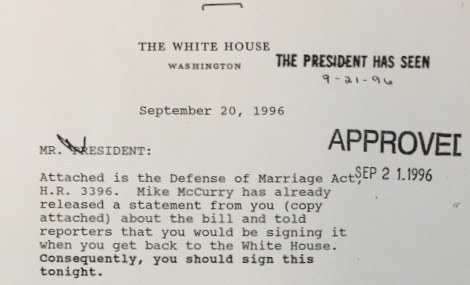
Clinton signed DOMA into law at 12:50 a.m. Sept. 21, 1996, upon his return to Washington on the day the bill was sent to the White House from Capitol Hill. In a statement issued upon his signing of the bill, Clinton reiterated many of the talking points from the memos circulated within the White House in the prior seven months.
Noting that he “strenuously opposed discrimination of any kind,” Clinton nonetheless said in the statement that he had “long opposed governmental recognition of same-gender marriages.” DOMA, he said in the statement, was limited to allowing states to make their own decisions about same-sex marriage and defining marriage as being only between one man and one woman under federal law.
Clinton concluded by stating that DOMA “should not … be understood to provide an excuse for discrimination … on the basis of sexual orientation.” This is so, he said in the statement, because “[d]iscrimination, violence and intimidation for that reason, as well as others, violate the principle of equal protection under the law and have no place in American society” — the only reference to the Constitution in Clinton’s statement.
Seventeen years later, Justice Anthony Kennedy would invoke that very same provision in striking down Section 3 of DOMA as unconstitutional.

On Dec. 9, 1996, after President Clinton was re-elected in a landslide against former Sen. Bob Dole, a student in New York sent a letter to the president.

“I want to begin this informal letter by congratulating you on your victory on November 5,” Adam Sanders wrote. He went on, though, to detail “why your support of the DOMA legislation really upset me.”
He told Clinton, “[Y]ou could have said ‘I do not support gay marriages. That has always been my policy, but this bill is garbage legislation clearly aimed at exploiting and hurting one group of Americans for political gain.’ … But you let the bigots win, and when they won you lost and America lost.”
Sanders, however, was willing to look forward: “You have made a mistake in backing down but one act alone does not define a presidency or president. … Please don’t let me or America down.”
Less than two weeks later, on Dec. 20, 1996, Clinton wrote back to Sanders.
“Thank you for your letter. I read it with great appreciation for your deep belief in me and my Presidency, as well as understanding over our disagreement on the same-sex marriage bill,” Clinton wrote. “You can be sure that I will continue to seek the path of courage and wisdom that will help me lead our nation during the next four years.”
